Related Research Articles
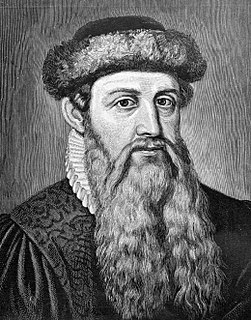
Johannes Gensfleisch zur Laden zum Gutenberg was a German goldsmith, inventor, printer, and publisher who introduced printing to Europe with his mechanical movable-type printing press. His work started the Printing Revolution and is regarded as a milestone of the second millennium, ushering in the modern period of human history. It played a key role in the development of the Renaissance, Reformation, Age of Enlightenment, and Scientific Revolution, as well as laying the material basis for the modern knowledge-based economy and the spread of learning to the masses.

Lucius Caecilius FirmianussignoLactantius was an early Christian author who became an advisor to Roman emperor, Constantine I, guiding his Christian religious policy in its initial stages of emergence, and a tutor to his son Crispus. His most important work is the Institutiones Divinae, an apologetic treatise intended to establish the reasonableness and truth of Christianity to pagan critics.

A manuscript was, traditionally, any document that is written by hand – or, once practical typewriters became available, typewritten — as opposed to being mechanically printed or reproduced in some indirect or automated way. More recently, the term has come to be understood to further include any written, typed, or word-processed copy of an author's work, as distinguished from its rendition as a printed version of the same. Before the arrival of printing, all documents and books were manuscripts. Manuscripts are not defined by their contents, which may combine writing with mathematical calculations, maps, music notation, explanatory figures or illustrations.

A printing press is a mechanical device for applying pressure to an inked surface resting upon a print medium, thereby transferring the ink. It marked a dramatic improvement on earlier printing methods in which the cloth, paper or other medium was brushed or rubbed repeatedly to achieve the transfer of ink, and accelerated the process. Typically used for texts, the invention and global spread of the printing press was one of the most influential events in the second millennium.
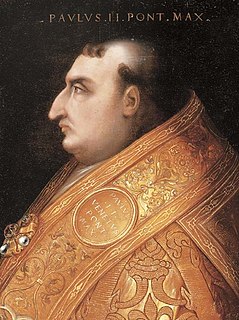
Pope Paul II, born Pietro Barbo, was head of the Catholic Church and ruler of the Papal States from 30 August 1464 to his death in 1471. When his maternal uncle Eugene IV became pope, Barbo switched from training to be a merchant to religious studies. His rise in the Church was relatively rapid. Elected pope in 1464, Paul amassed a great collection of art and antiquities.

Movable type is the system and technology of printing and typography that uses movable components to reproduce the elements of a document usually on the medium of paper.

Garamond is a group of many serif typefaces, named for sixteenth-century Parisian engraver Claude Garamond, generally spelled as Garamont in his lifetime. Garamond-style typefaces are popular and particularly often used for book printing and body text.

Johann Fust or Faust was an early German printer.

The history of the books became an acknowledged academic discipline in the 1980s, Contributors to the discipline include specialists from the fields of textual scholarship, codicology, bibliography, philology, palaeography, art history, social history and cultural history. Its key purpose is to demonstrate that the book as an object, not just the text contained within it, is a conduit of interaction between readers and words.

Subiaco is a town and comune in the Metropolitan City of Rome, in Lazio, central Italy, 40 kilometres (25 mi) from Tivoli alongside the river Aniene. It is a tourist and religious resort thanks to its sacred grotto, in the medieval St Benedict's Abbey, and for the Abbey of Santa Scolastica.

The German Renaissance, part of the Northern Renaissance, was a cultural and artistic movement that spread among German thinkers in the 15th and 16th centuries, which developed from the Italian Renaissance. Many areas of the arts and sciences were influenced, notably by the spread of Renaissance humanism to the various German states and principalities. There were many advances made in the fields of architecture, the arts, and the sciences. Germany produced two developments that were to dominate the 16th century all over Europe: printing and the Protestant Reformation.
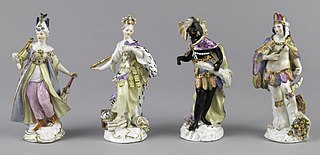
Personification occurs when a thing or abstraction is represented as a person, in literature or art, as an anthropomorphic metaphor. The type of personification discussed here excludes passing literary effects such as "Shadows hold their breath", and covers cases where a personification appears as a character in literature, or a human figure in art. The technical term for this, since ancient Greece, is prosopopoeia. In the arts many things are commonly personified. These include numerous types of places, especially cities, countries and the four continents, elements of the natural world such as the months or Four Seasons, Four Elements, Four Winds, Five Senses, and abstractions such as virtues, especially the four cardinal virtues and sins, the nine Muses, or death.
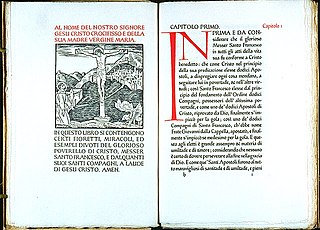
The Ashendene Press was a small private press founded by St John Hornby (1867–1946). It operated from 1895 to 1915 in Chelsea, and was revived after the war in 1920. The press closed in 1935.
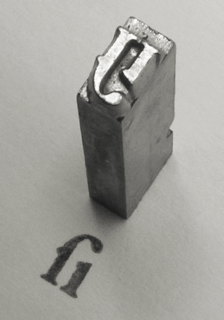
Modern typographers view typography as a craft with a very long history tracing its origins back to the first punches and dies used to make seals and coinage currency in ancient times. The basic elements of typography are at least as old as civilization and the earliest writing systems—a series of key developments that were eventually drawn together into one, systematic craft. While woodblock printing and movable type had precedents in East Asia, typography in the Western world developed after the invention of the printing press by Johannes Gutenberg in the mid-15th century.
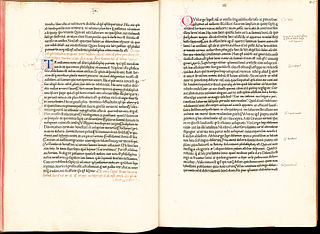
Arnold Pannartz and Conrad Sweynheym were two printers of the 15th century, associated with Johannes Gutenberg and the use of his invention, the mechanical movable-type printing press.
The brothers Johann and Wendelin of Speyer were German printers in Venice from 1468 to 1477.
Giovanni Andrea Bussi (1417–1475), also Giovan de' Bussi or Joannes Andreae, was an Italian Renaissance humanist and the Bishop of Aleria. He was a major editor of classical texts and produced many incunabular editiones principes. In his hands the preface was expanded from its former role as a private letter to a patron, to become a public lecture, and at times a bully pulpit.
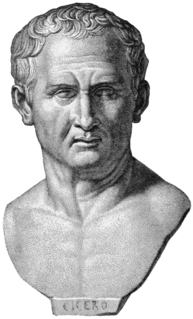
Consolatio is a lost philosophical work written by Marcus Tullius Cicero in the year 45 BC. The work had been written to soothe his grief after the death of his daughter, Tullia, which had occurred in February of the same year. Not much is known about the work, although it seems to have been inspired by the Greek philosopher Crantor's ancient work De Luctu, and its structure was probably similar to a series of letter correspondences between Servius Sulpicius Rufus and Cicero.
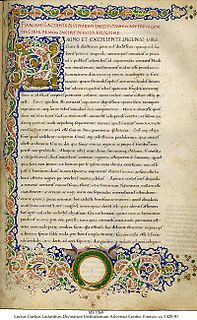
Institutiones Divinae is the name of a theological work by the Christian Roman philosopher Lactantius, written between AD 303 and 311.
Italy is the home of two of the world's biggest publishers of books in terms of revenue: Messaggerie Italiane and Mondadori Libri. Other large publishers include De Agostini Editore, Feltrinelli and the RCS MediaGroup.